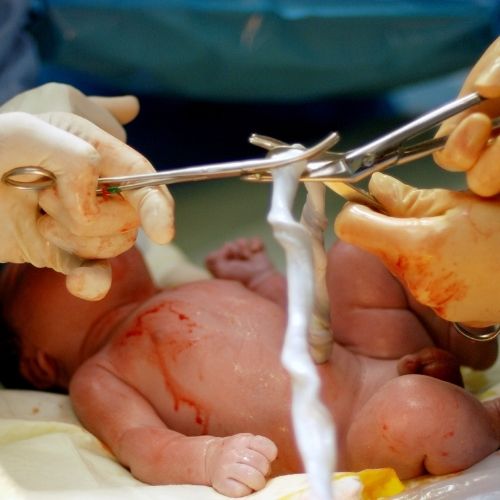Delayed cord clamping is definitely a buzz word in the birth world. But what exactly is it? What are the benefits and risks of delaying cord clamping?
There are many myths and theories around cord clamping, so I’m here to present you with the cold, hard facts. As a labor and delivery nurse and mom to three, it’s something I deal with quite often.
What’s so special about the cord blood?
When you get pregnant, your body creates a beautiful placenta. It’s essentially the filter between mom and baby: the placenta attaches to the wall of the uterus and is a place where oxygen, nutrients, and waste are exchanged.
Attached to the placenta is the umbilical cord and membranes, also called baby’s sac. This houses the baby and the amniotic fluid. When we talk about “breaking the water” or “water breaking”, we are referring to the breaking of the membranes.
The umbilical cord attaches the placenta to the baby. It’s essentially their lifeline in the womb! After the baby is born, the placenta is still pulsing, meaning there is still blood flow from the placenta to the baby. That oxygen-rich blood can be very beneficial to a newborn.

The benefits of delayed cord clamping
In the past, the baby was born and the cord was clamped immediately. After all, once the baby starts breathing, there’s no need for that oxygenated blood from the cord, right?
Wrong! There are so many benefits to delayed cord clamping!
The benefits of delayed cord clamping include improved iron stores and less risk for anemia, improved hemoglobin, better transitional circulation, more red blood cells (and a lesser risk of a baby needing a blood transfusion), and lower incidence of necrotizing entercolitis. All of this information can be found on the ACOG website.

The risks of delayed cord clamping
There are few risks that come along with delaying the clamping of the umbilical cord.
First, there is an increased risk of neonatal jaundice. This is due to the extra red blood cells that come from the umbilical cord after birth. This is because babies need to break down excess red blood cells, and as a result this increases their bilirubin levels. This is a common finding in newborns and neonatal jaundice is easily detected and treated.
If a baby needs resuscitation after birth, doing delayed cord clamping can delay that care of the baby. This is not always true, and some resuscitative measures can be done while the newborn is attached to its mother. However, in some hospitals the newborn resuscitation equipment is not near the mother’s bed, and so the cord must be cut for access to that equipment.
How long should you wait to cut the umbilical cord?
The guidelines on delayed cord clamping are evolving. Some studies say 30 seconds is effective, but as more research is done we are finding that at least 1 minute, up to 5 minutes, can be beneficial.
One study showed that infants who experienced delaying cord clamping for 5 minutes after birth while the infant was skin to skin with its mother had greater ferritin (iron) levels and increased brain myelin. They compared these infants to those who experienced immediate cord clamping (click here to review the study).
Many providers are choosing to wait until the cord stops pulsing. This typically happens within the first three minutes of birth. After the cord stops pulsing, the transfer of blood between mom and baby is complete. If you are planning on writing a birth plan, this is a good thing to include if it’s important to you.

Can you do delayed cord clamping and cord blood banking?
Whether or not you can do both cord blood banking and delayed cord clamping is up to a few different factors.
Some cord blood banks require more blood than others. Also, it can depend on how much blood is in the cord. Some umbilical cords are thick and plump while others are smaller.
If you are choosing private cord blood banking, talk with the coordinator to see if you can do delayed cord clamping as well. They are the ones who will have the best info about their collection kits.
It’s always important to talk to your doctor about delayed cord clamping. They are the best ones to walk you through the benefits and risks!


